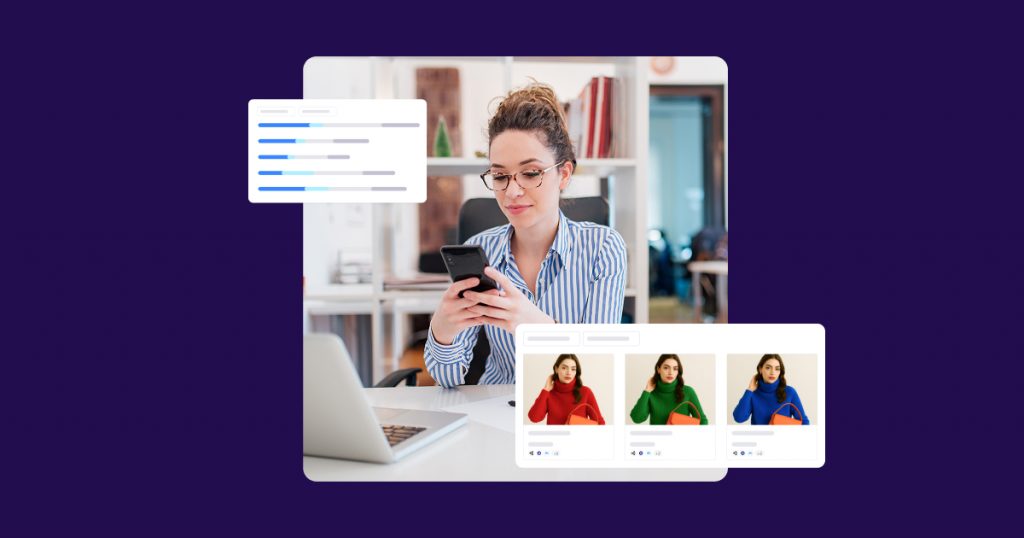
Introduction
What’s happening with user acquisition?
The app age has obviously matured since its infancy – just a decade ago – but it certainly has not stopped growing. The key performance indicators you care about as an app marketer continue to generate impressive upward trajectories.
Look back and you see double-digit year-over-year growth.
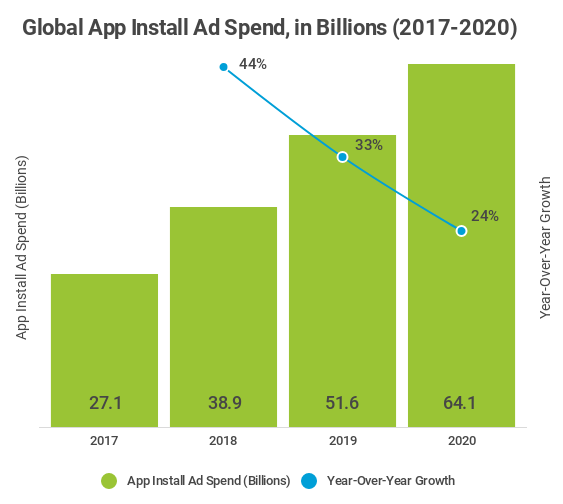
Look forward and the trend is projected to continue into 2020.
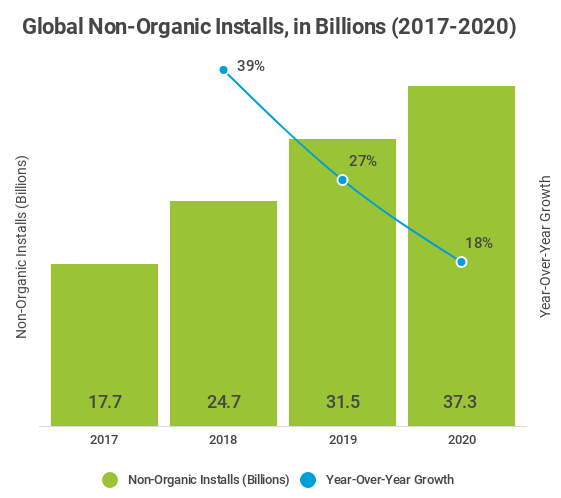
Non-organic installs – realized from paid and owned marketing activities – will also see the bars get taller each year and an arrow pointing steadily higher.
Look even further forward and the app economy continues burning bright.
According to the App Annie 2017-2022 forecast:
- Annual consumer spend in app stores will reach $157 billion by 2020 (up 92% from 2017)
- Average annual consumer spend will reach $26 per device by 2020 (up 23% from 2017)
Will your apps be joining the party?
Obviously, the raging hot app market bodes well for those capable of staying in step with the demands of their verticals and mastering data-driven marketing.
However, it should be equally obvious that in every crowd you have leaders, laggards and a vast array of competitors in between.
Just like in every type of business, in the case of mobile apps, marketers are responsible for attracting and keeping customers.
In this guide, we’ll focus on the former, which is known as user acquisition, or UA.
User acquisition is the method of driving new users to a mobile app business through marketing activity.
UA primarily takes the form of paid media marketing, owned media marketing, and app store optimization (to maximize organic traffic).
User acquisition matters because:
- Growth in the freemium-driven app economy depends on capturing the small minority of users (roughly 5-7%) who contribute to in-app purchase revenue
- Amidst an explosion of apps, the mobile ecosystem has witnessed a decline in the share of organic installs due to broken app discovery
- Effective strategies boost your app store rankings which, in turn, leads to more UA.
So, how do you master user acquisition?
Like any critical skill, you begin with a strong command of the basics.
In this guide, you’ll learn more about the most prominent UA challenges and the critical elements of planning, executing, and continuously optimizing your UA efforts.

Chapter 1
Attribution and marketing analytics
You’re a mobile marketer and you’re ready with a cross-device marketing strategy. Based on your app’s goals and road map, you’ve positioned your team to maximize user acquisition and gather crucial insights for future re-engagement activities.
But how do you know what is working and what is not?
Enter mobile attribution and the marketing analytics.
Mobile (install) attribution is a method for determining which marketing activity delivered specific app installs.
Marketers can take data acquired from attribution, broken down on a granular level, and tie it back to performance, revenue, and any number of other post-install activities.
How attribution can boost your app’s profitability?
1. It helps inform user acquisition decisions
When done by a reliable, unbiased attribution provider, mobile attribution can pinpoint the value of specific channels, media sources, publishers, campaigns, and even creatives, in turn allowing you to optimize your app’s performance.
With the wealth data attribution provides, you can easily boost lifetime value (LTV) and ROI, and understand exactly where you should (or shouldn’t) spend your budget.

For more information on how to use attribution data to optimize your campaigns, see Chapter 7.
2: You can consolidate your advertising ecosystem into a single SDK
The technical challenges of working with ad networks without an attribution provider are numerous.
As a general rule, all networks require an SDK for measurement and optimization, each of which typically needs different implementation, integration, and quality assurance that can unfortunately cause major data discrepancies if not set up properly.
And that’s before your operation gets bigger.
Scaling for app marketers who are attempting to manually implement their own attribution means costly new SDK integrations for each ad network they want to add; slowed progress; drained resources; and even negative app performance.
Instead of numerous SDKs resulting in confusion and discrepancy, an app will integrate a single SDK that measures and performs attribution for all of its ad networks.
When you integrate with a universal SDK, you can know that your provider has already done the heavy lifting and will be able to connect you to your entire mobile ecosystem:
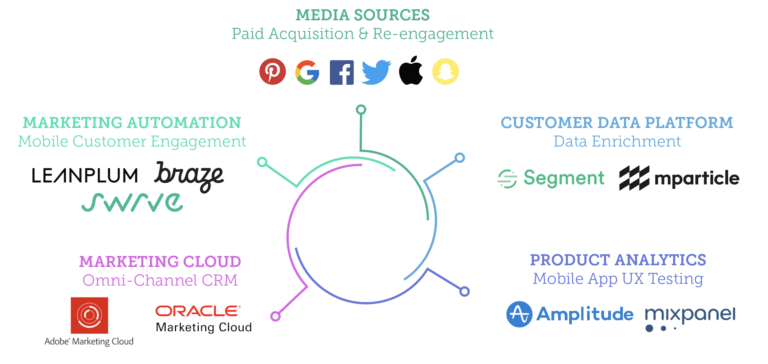
3: It removes double or triple charging by ad networks
Last-touch attribution currently ranks as the standard for attribution modeling and understand the source of installs.
This means that the ad network that last “touched” (with an ad view or click) the user gets the full credit.
However, the reality of the user journey is one of multiple touch points before install, which means interactions with multiple media sources. Without a reliable source of attribution, each network that logged a touch on a multi-touch user journey can claim credit and charge you for an install.
Why? Because media sources only see their own touches.
Especially as a marketer running campaigns on several media sources, you might easily pay double or triple.
With no dog in the fight, so to speak, an impartial attribution provider trusted by both advertisers and media companies can pinpoint the last touch and connect the entire user journey to future UA and re-engagement decisions.
More importantly, the impartiality gives both marketers and media partners alike confidence that the data is accurate and indisputable.
In the end, you pay one source only and everyone is happy (again, assuming last touch standard in place).
How to make attribution work for you
With a fractured mobile landscape and many connections that need to be solidified in order for accurate data to reach your dashboards, your attribution provider can leave no room for error.
But what are the characteristics that make up a good provider and what can you expect as you make this crucial decision?
There are many, but here are the top 3:
1. Established, unbiased, and well-connected with the ecosystem
Any marketer running paid user acquisition campaigns is likely working with the biggest media sources out there: Facebook, Google, Apple, Twitter, Instagram, Snapchat, and the Chinese giant, Tencent.
That means they need an official mobile measurement partner who has been extensively vetted for their innovation, service excellence, expertise, and record of success – and who is held to the highest security standards for data integrity.
You should consider the depth of integration your potential provider has with these media sources; include their offerings for impressions, clicks, cost, and the ability to automatically run audience campaigns (such as remarketing and lookalikes) in your analyses.
Otherwise, you may risk missing large chunks of mission-critical data from the highest performing networks.

2. Large scale and market share to block fraud
Mobile ad fraud is a pervasive and inevitable challenge in mobile – preparing your app’s infrastructure for potential attacks now before they become a problem will pay off in the future.
The latest study by AppsFlyer on the global state of mobile fraud showed that almost 1 in every 4 installs is fraudulent. No doubt, effective fraud protection is a must have.
Because of the continuous evolution and increased sophistication of fraudsters, your attribution provider must have two ingredients to be effective:
- Massive cross-network scale with significant market penetration
- Machine learning to pull actionable insights from the data and identify new forms of fraud before they inflict serious damage
These qualities, paired with multi-touch attribution capabilities and a secure SDK, will make it much harder for fraudsters to attack… and win.
3. Trustworthy security and privacy infrastructure
While an extensive integrated partner network and powerful fraud blocking capabilities keep your data aligned with your business goals, no attribution operation ultimately exists without a tight security and privacy infrastructure to back it up.
After all, your data is your most important asset that must be safeguarded.
You should look for an enterprise-grade solution that not only was built upon a wide range of policies and procedures (like access management, security for personnel, product, and network, security monitoring, and incident response, among others) but prioritizes your security as mission-critical and operates in real-time.
Attribution is the most important component in the mobile marketing tech stack.
For more on mobile attribution and marketing analytics, check out Getting Started with Mobile Attribution.

Chapter 2
The app market’s most prevalent user acquisition challenges
Organic app discovery is broken.
It’s a sobering reality of the app business.
Any one app is now a needle in the gargantuan haystacks that are the two dominant app stores.
To seize control of your destiny is to embrace the notion that non-organic traffic is key. But it’s not like you flip on the paid marketing switch and users come pouring in.
The cost of paid UA keeps rising while user retention and monetization, unfortunately, continue to pose significant challenges.
Challenge 1: Churn burns
It’s no secret an app’s retention rate is another all-important mobile marketing metric.
Loyalty means money.
Churn burns.
Users are demanding, finicky, and painfully fickle.
A study of retention benchmarks for days 1, 7, and 30 based on 1.6 billion installs makes clear retention is hard to achieve and progress comes slowly.
However, a close inspection of the data presented above reveals loyalty is up to 20% higher with non-organic users.
Although retention numbers are still painfully low, this increase is encouraging as even small gains in retention have been known to have a significant impact on lifetime value.
Want to dig deeper into retention data and analyze it based on geography and vertical markets? Help yourself to our free 2018 App Retention Benchmarks Report.
Challenge 2: Fragmentation
Welcome to the world of mobile, where the following are forever part of the immensely fragmented fray:
- A load of device types
- Two (dominating) and completely different operating systems: Android and iOS
- Environments for both the mobile web and apps
- Multiple identifiers
Clearly, the fragmentation of the mobile landscape poses a series of challenges for strategy, optimization, and measurement
Challenge 3: Omni-channel measurement
In mobile marketing, you have to broach the subject of omni-channel attribution and measurement. But it tends to make heads spin.
How do you connect the dots and craft a unified user experience across multiple devices and touchpoints?
Challenge 4: Escalating media costs
As you would suspect, increased demand causes UA costs to rise. Not to mention acquiring users that complete in-app purchases can be even more costly.
The most important thing to understand about rising costs is that marketers who rely heavily on data have confidence to invest in marketing and drive profitability.
Challenge 5: Monetization
The share of app users who go on to make an in-app purchase (IAP) stands at a mere 5-7%.
In a freemium-driven space where most apps make money from IAPs, finding revenue-generating users remains elusive. The use of in-app advertising – another important revenue stream – is on the rise, but it is mostly relevant for gaming and utility apps.

Challenge 6: Fraud
Mobile app install fraud is more prevalent than ever.
Why does the level of attempted fraud remain so high?
Because beyond the obvious financial incentive for fraudsters, there are many marketers who are still unaware of the threat.

App marketers without fraud protection are exposing themselves to potentially catastrophic results.
Not only are they wasting their budgets on fake or organic users, they are basing their entire optimization efforts on data that is completely wrong!
To better understand the threat of mobile ad fraud, take a look at this report.
User acquisition challenges continue to mount.
App marketers must stay on top of the latest with paid marketing trends to reduce wasted spend and address fragmentation. Throughout this guide, you’ll gather important tactics for overcoming these challenges.

Chapter 3
Media categories: Where to connect with new users
Digital marketers have come to know a modern media universe often described by the acronym PESO, which stands for:
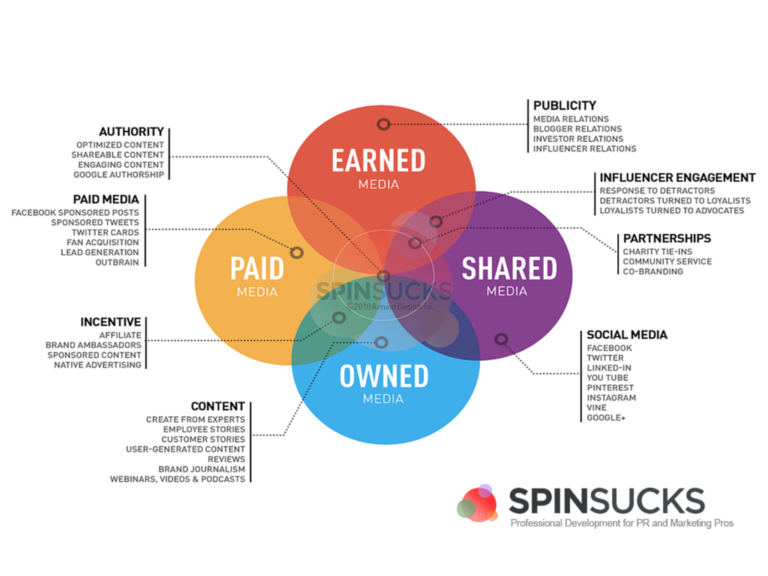
There are your four media categories.
It’s no secret that organic search, or SEO, goes in the “earned” file. Essentially, you have to earn (and it’s far from easy) the golden real estate that is a top 10, or page one, position for any given keyword search on Google or the other prominent search engines.
In the world of app marketing, while ranking on a web-based search engine (or being featured on the results page in any way) is obviously a good thing, apps are far more concerned with visibility in the two almighty app stores – Google Play and Apple’s App Store. The practice of earning exposure there is called ASO, which stands for App Store Optimization.
For more on the fundamentals of ASO, see Chapter 8.
This chapter will focus on the following media types:
- Paid
- Shared
- Owned
Paid media: You get what you pay for
The world of paid media, which is essentially advertising in its various forms, has witnessed remarkable change in the 21st century. In a nutshell, traditional media such as broadcast, print, direct mail, and outdoor advertising have taken a massive slide, as the dollars continue to pour into digital.
Data from PwC shows online advertising has overtaken TV advertising and will continue surging far past it.
Online advertising is forecast to be a $127 billion market by 2020 – about 70% larger than the forecast for TV advertising.
Paid digital media offers a powerful set of benefits – namely optimization, control, scalability, and accountability through measurement.
And leading the charge among digital ad channels is mobile.

eMarketer estimates that nearly 34% of all media spend in the US is already going towards mobile advertising, with that share projected to rise to nearly 48% in the next three years.
It can be difficult to know where to prioritize media allocation, as each channel has its own costs and benefits. The ad buyer is forever challenged to examine and optimize ad spend to increase ROI.
Prominent UA channels in paid media
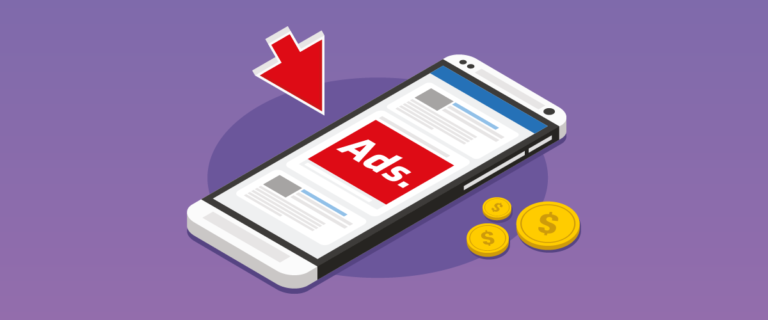
The social giant focused on mobile early, a decision that propelled it to become the largest media source in app install advertising today. Beyond its massive global reach, Facebook offers a robust self-serving ad platform enabling app marketers to optimize for installs and / or in-app events.
Extensive optimization options enable you, among other things, to buy per device, OS, custom audiences, lookalike audiences, and exclude those who previously installed your app.
Google App Campaigns
App marketers should think of Google as a network because its App Campaigns give you access to users across the AdMob network, search, display, Google Play, YouTube, and Gmail. You can set everything up from the Play Developer Console.
UAC is driven by automation and machine learning, leveraging its immense scale of data behind the scenes to guide optimization. Although much of the ad creation and delivery is automated, advertisers must understand what works to set the right goals, guide bidding, and produce the most effective creative variations.
The bold move to UAC has paid off for Google – it has considerably increased its share in the app install ad pie since the 2017 launch.
Apple Search Ads
Apple Search Ads App help apps get discovered in Apple’s App Store. Leveraging powerful search intent has turned this channel into an extremely important source of traffic for apps targeting markets with a high percentage of iOS users.
Advertisers set daily or total campaign budgets based on keyword search terms. Apple Search Ads are created automatically by selecting images and copy found within the metadata the app publisher or developer supplies.
Features include customer type, gender, age, and location. Apple also provides advertisers with a keyword suggestion tool, popularity indicators and negative keyword capabilities.
Facebook-owned Instagram has always been a mobile-first platform, so it’s ideal for app install ads. Its growing popularity also means advertisers can scale through this platform.
Like Facebook, a variety of formats are available including photo, video, and carousel ads. Advertisers use Facebook Ads manager, which makes it easy to try ads on both platforms as well as reuse ads that worked well on the other platform.
Twitter claims that 83% of its users are on mobile and on the lookout for apps.
App Cards allow advertisers to prompt audience members to download or open apps directly from within a Tweet. It’s a powerful ad format that displays an image preview, app ratings, and supports direct installs.
Twitter campaigns offer a “cost per app click” pricing model to ensure you only pay for clicks that lead to the App Store or Google Play.
Snapchat
Snapchat is a fast-growing platform embraced widely by members of Generations Y and Z. Advertisers can target by location, age, gender, mobile network, device or OS, and the types of content users engage with.
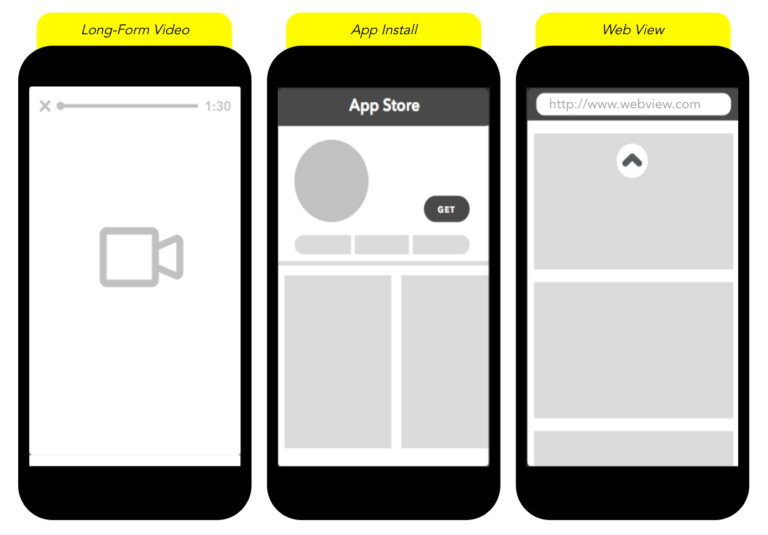
A Snap ad can be a 10-second video or an interactive ad that lets users swipe up to watch a longer video, read an article, access a mobile website or install an app. Snapchat uses a cost per view model, charging advertisers as soon as the video ad starts.
Ad networks
There are two main types of mobile ad networks selling media to app marketers:
- Premium SDK networks
These are networks who require their SDK to be implemented in the monetizing app as it enables the use of complex and proprietary ad units such as rewarded video or native ad types.
Premium SDK networks usually work directly with media property owners or app developers with inventory to sell. As such, every publisher is heavily vetted, ensuring more accountability and less fraud. Key players include AppLovin, ironSource, Unity Ads, Vungle, and Tapjoy. - Affiliate networks
An affiliate network is essentially a platform that facilitates the exchange of supply and demand between publishers and advertisers. It is considered an effective tool to drive scale.
However, these networks don’t necessarily know who their publishers are, while the media is often re-brokered on multiple layers. As a result, there is far less visibility and control, which could lead to higher rates of fraud.
Demand Side Platforms (DSP)
A Mobile DSP is a programmatic technology platform that enables automated media buying at scale. App advertisers are able to bid in real time auctions of multiple ad exchanges using a single interface.
Its advantages are mainly increased transparency (sites, ads, bids), access to wider inventory (rather than buying a single media partner’s limited inventory) and multiple optimization options (contextual and behavioral).
In-app header bidding, also referred to as a “unified auction,” is a programmatic ad booking technique that allows mobile app publishers to offer ad inventory to all demand sources at the same time – in real time. Each ad impression is simultaneously offered and sold to the highest bidder from any type of demand source.
Media buyers compete fairly on every piece of ad inventory at the same, not just the small percentage of inventory seen on their rank in the waterfall.
Alternative paid channels
The primary UA channels covered above are obviously proven sources. But in the highly competitive app space, app marketers should also look beyond to drive more demand for their app.
This includes:
- Android pre-installs
Preloading puts your app on millions of targeted devices at the moment of maximum engagement: unboxing and activation. Though the availability of preloaded app real estate is obviously limited, there are opportunities to target users in emerging economies.
Ad networks like Digital Turbine specialize in partnerships with device sellers to include bundles of preloaded apps. - Influencer outreach
Influencer marketing for apps involves forging relationships between your brand and specific influencers who are trusted figures within a specific niche. The influencer promotes your app through media platforms such as Instagram and YouTube to propel your brand.
The idea behind reaching out to influencers and compensating them is to get them to create authentic content. Influencer-generated content is found to perform even better than user-generated content. Influencer marketing has become a potent answer to the rising use of ad blockers by consumers, the escalating costs of native advertising (social and otherwise), and the mind-boggling overload of content in general.
Earned, owned, and shared media channels

Content marketing
It’s often said, “content is king” in online marketing and it’s unquestionably a key to app sustainability as well.
Content marketing for apps gives you a channel – over which you have complete control – where you can reach new audiences and boost traffic.
Video can be a very effective content medium for app marketing as well. App demos, promotional videos, and user-generated videos can attract an audience and inspire viewers to share.
In addition to content mainstays such as blog posts and videos, you can create infographics, ebooks, guides, templates, quizzes, contests and many other types of content.
The key is to ensure every piece of content provides value.
Organic social media
Social media is one of the top channels to include in your UA strategy.
Content posted on social media networks can reach a large audience tool and increase app installs.
You’ll want to follow top publications and industry leaders, connect with their audiences, and engage as often as possible to build your following.
Social media evolves quickly so tune-into how the networks that matter most to your business and stay on top of the trends. For instance, live streaming has taken off in recent years.
Internet community forums
You can get your app and content in front of a very targeted audience via forums, Q&A websites, and social media groups. Each of these channels are no-cost alternatives to paid advertising and allow you to communicate directly with your target audience.
Of course, be careful to be a good citizen of the communities you participate in and stay far away from being spammy or overtly promotional.
Loyalty programs
A loyalty program can help inspire users to become evangelists of your app. Loyalty program tactics often include:
- A reward system, such as discounts
- Gamification, such as unlocking a new feature based on referrals
- Connecting app marketing to traditional marketing by allowing users to earn and measure loyalty rewards obtained in-app, in-store, or online, on their mobile app

Word of mouth
Word of mouth, or WOM for short, is and always has been the most persuasive form of marketing.
In addition to reward programs and store ratings and review, you can foster more word of mouth by making your app easy to share.
Build social sharing capabilities and social integration features into your app.
Email marketing
App marketers should not underestimate the power of email marketing. The majority of emails are now opened on mobile devices, making the channel a prime candidate to direct prospects to your app store page.
Consider using email marketing to promote your content, share product updates, offer discounts, and announce upcoming events. Email is also a great way to connect with your audience on a personal level with birthday wishes, personalized offers, and timely content recommendations.
Also, use email to request and collect feedback. Ask recipients to reply with insights regarding how you can improve your app.
Mobile website
If you have a mobile app, chances are you also have a mobile website, especially if you’re in the travel or shopping verticals.
The website is extremely underleveraged, but can be an excellent touchpoint to expose users to your app, either through incentives (such as exclusive club membership, discounts, or seasonal promotions) or by showcasing how the app can enhance the web and mobile web experience.
Consider adding stellar ratings, a quick tagline, and/or your App and Play Store icons to increase chances of app install.
SMS/Texting
The top used feature on smartphones is texting, and texting has the highest engagement rate of any marketing medium.
SMS is an informal and highly personal channel, so it’s ideal for entertaining campaigns, which may include games, promotions, polls, interactive content, and of course, one-on-one conversations.
Press coverage
Press coverage in the publications that are most relevant to your audience may be your best source of organic traction.
However, tech journalists receive dozens of press releases every day, via email, from companies seeking press coverage. When pitching, remember that your subject line is all-important. It’s also important to make your pitch extremely brief, descriptive and exciting.
You’ll also need to be prepared with a solid press kit.
The items you’ll likely want to include in your press kit are:
- App icon
- App Screenshots
- App review guide
- Press release
- Demo video
- Company profile
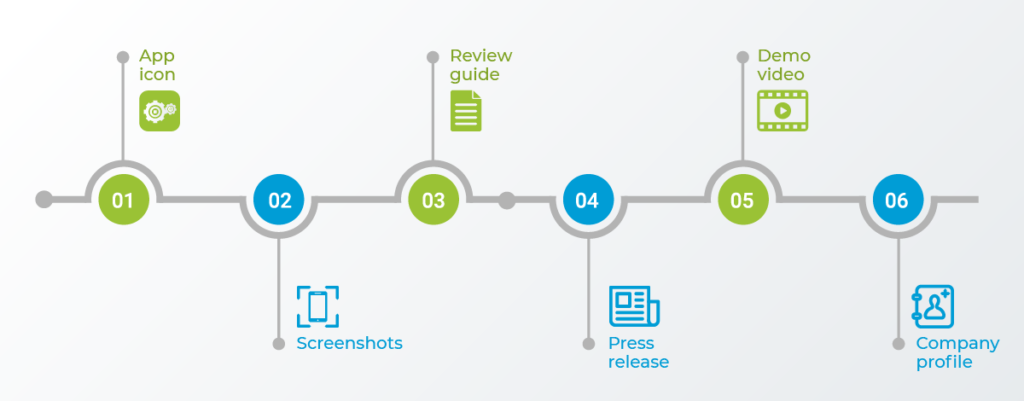
App Store Feature
The pinnacle of unpaid, earned media for apps is getting featured in app stores. Both Apple and Google regularly review apps and prominently display their top recommendations, which will have a dramatic effect on driving installs.
Consider the following tips to increase your chances of being featured:
- Ensure your app store page is highly persuasive
- Create an enticing icon
- Keep your ratings high
- Create buzz for your app via social media and all forms of online marketing
QR codes
As a marketing tactic, QR codes may not have lived up to expectations but often work to increase UA.
QR codes are, of course, mostly used to engage smartphone users. Plus, QR codes are easy and free to create.
Places you can offer potential users QR codes include:
- Email signatures
- Social media
- Print ads
- Posters, banners and billboards
- In-store
- Websites
- Business cards
Selecting the right media partner
As you have undoubtedly surmised, you’re faced with an overwhelming number of options when it comes to making media choices.
Choosing wisely calls for having access to up-to-date, accurate, and objective insights regarding mobile media sources.
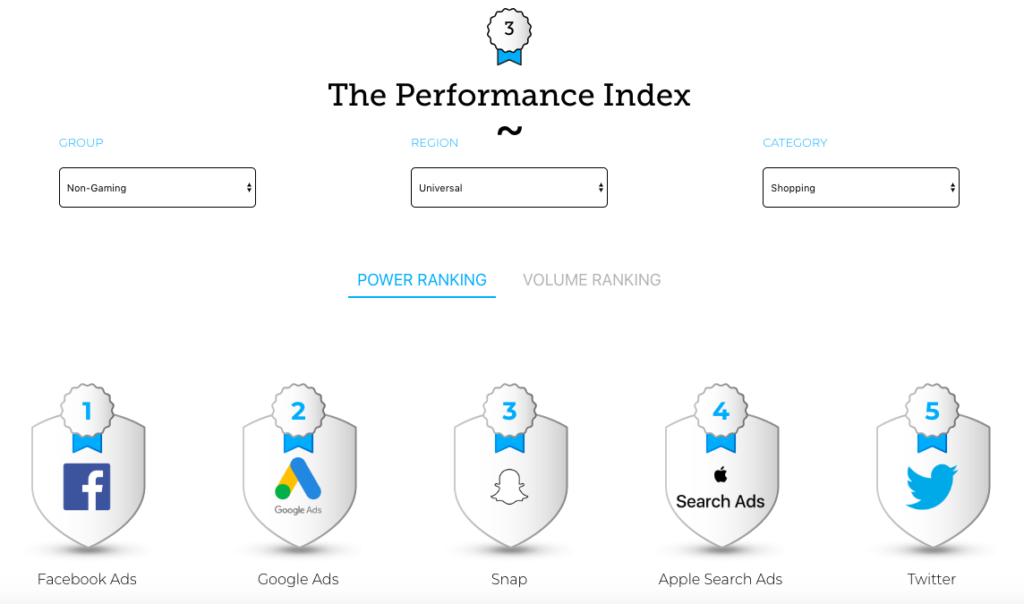
On that front, AppsFlyer has great news for you: each year we publish the AppsFlyer Performance Index, the industry-standard and most comprehensive report card on the performance of mobile media sources.
The index features rankings by categories and game genres and covers hundreds of media sources in multiple regions across the globe.
It’s also important to make sure you’re always up-to-date on the trends of the industry. Read trusted industry blogs and trade publications. Develop relationships with industry peers and trusted thought leaders via online communities. Attend conferences, workshops and other events.
A note on mobile ad fraud
As described in Chapter 1, app install fraud is significantly contaminating the ecosystem, with nearly 1 in 4 installs being fraudulent!
A big part of the problem can be attributed to the media side.
There are two main reasons for this:
- The digital advertising ecosystem involves many layers of resellers, with little in the way of oversight and transparency
- There are media companies who are taking little to no action against fraud, and many of these have repeatedly been excluded from the AppsFlyer Performance Index for failing to meet the threshold
Therefore, demand transparency from your media partners, and more importantly take everything they say with a grain of salt (some don’t even know they are being attacked).
Instead, take matters into your own hands and protect yourself!
A few more tips
- Think quality first… but don’t forget quantity matters in UA advertising too, so try not to reel in the scope of your media buys.
- Are the partners you’re choosing self-service? Know what you’re getting into. You’ll prefer the self-service model if you want to make changes on the fly, whereas managed service might be more comfortable for you if you intend to make bulk buys without the need for agility.
- Remember to closely examine your optimization options.
How many media partners should you work with?
Ever wonder how many media partners your competitors have?
We did, so we examined over 1,100 apps to reveal:

Insights we drew from the data include:
- Spend and network quantity is highly correlated
- More media sources create more room for optimization
- It’s important to reach the same users in different contexts – the more media sources you work with, the greater the ability to create meaningful interactions
- The key is to not be too exposed and reliant on one network, but to ensure your media mix is diverse and that you’re constantly testing
Conclusion
App marketers today connect with new users across the spectrum of paid, earned, shared and owned media.
Understand your options and pursue prominent paid media channels when you seek greater control and more immediate results.
However, to increase your reach and lower you costs, continue to integrate earned, shared and owned channels, including content marketing and social media marketing.

Chapter 4
How to set up and test UA campaigns
How do you translate your business goals into a marketing goal, and what processes are needed to ensure you are setup for success?
This is the key question you need to ask yourself before getting started.
Let’s examine some of the steps needed to maximize your success through test UA campaigns.
Set ROAS goals
As a performance marketer, you seek ROAS (Return On Ad Spend) and aim to improve LTV.
The goal is to work backwards from LTV to discover what levers to pull.
Understanding the user journey within your own environment gives you the ability to predict what users are likely to do when they trigger certain app events. This allows you to understand the value of your various paid media efforts.

Applying these values makes it easier and more predictable to forecast ROAS and optimize your campaign.
Ask yourself:
- What kinds of user actions in your app can you map to different stages of the journey towards purchase?
- Are you trying to optimize campaigns for maximum installs or for maximum post-install in-app events?
- Will higher CPI costs deliver higher ROAS?
Deciding on what to measure is therefore a critical component of set up as it is the foundation of success.
Aim for granularity, but don’t measure too much at first.
Check out this video for a great app measurement framework your can adopt.
Tag wisely
You need to setup granular tagging in your attribution link that can pinpoint different elements and segment based on variables such as the creative, the campaign, the test, and the channel.
Example:
CampaignName_AppName_Vertical_Channel_TargetingGroup_CreativeConcept_Device_NewCustomers_AngryBirds_Social_Facebook_18-25CasualGamers_RedBird_Android
Set budget strategy
As we discussed in Chapter 3, understating how much we should invest into the growth of our products is a vital component of successful UA.
Test your creatives
Many campaigns are test campaigns.
Why? Because you need to know what resonates with your audience.
To arrive at the answer you can test variations of images, headlines, copy, and any other creative element.
A campaign built on three images with three titles produces a test bed of nine creatives. Of course, you can easily add additional variations to create another layer.
Develop a framework that enables you to test your hypothesis, learn from your winners and losers, and respond accordingly. Stay focused and make sure you emphasize tests that have the potential to yield actionable insights.
Testing tips:
- Start with the hypothesis – determine why you are conducting the test and what you expect to learn
- Define data-driven goals for success
- Determine what your minimum sample size for statistical significance should be and make sure to compare results with a “clean” variant
- Only name your test winner when you’ve used data from a trusted attribution provider
- Lastly, define the time frame given to the media source to reach the goals
- Know in advance what steps to take after gathering results
- Examine the resources required to setup your tests
- Understand if your tests are scalable
- Research testing tactics – read, investigate, ask peers, join a community and take advantage of the many experienced, knowledgeable, and friendly marketers out there
- Get key info from media partners that are new to you before experimenting with them
- Are they self-serve or managed?
- Is their inventory direct or non-direct?
- What level of transparency is offered?
- How much of their inventory is “exclusive”?
- Which ad formats do they offer (always evaluate based on an actual live preview – not just the listed specifications.)?
- Define legal terms and include an opt-out clause in the contract where it is clearly stated under which terms a test can end.
In general, you must adopt an always-be-testing mindset in whatever you do.
Check out this video for proven methods to get your app marketing testing going.
Segment for better user engagement
Your marketing reaches new levels – and the quality of your UA reaches new heights – when you build smart, dynamic, specific audience segments.
Audience segmentation is dividing people into homogenous subgroups based on criteria such as:

Here are five ways you can improve UA performance with segmented audiences:
- Drive quality users
Constantly update your segmentation criteria and allocate more budget where you get the highest quality - Lookalike audiences
Identify prospects that ad platforms identify as similar your best users - Uninstall recovery/exclusion
Identify users who recently uninstalled your app to drive reinstalls, or exclude them from further segmentation - Exclusion segmentation
Remove users you are trying to engage on Network A and need not engage on Network B… or create an audience segment of problematic users and exclude them from your re-engagement campaigns - Cross-app promotions
Identify users that were once active, but aren’t currently with ads about your newest release
The process of optimizing your UA campaigns begins with setting ROAS goals and requires careful analysis and testing of your creative executions.
Apply the testing tips presented here to continuously refine your campaigns. You’ll also want to create audience segments to further improve UA performance.

Chapter 5
Strategic budgeting for user acquisition
Each year, marketing professionals prepare their budget allocations anew.
The area of paid user acquisition is key for hitting growth targets for mobile apps, so it’s important to carefully consider how to budget for it effectively.
Let’s take a look at some considerations, practical advice, and key takeaways for coming up with the best possible UA paid media budget for your campaigns.
Key considerations for UA budget planning
Your main concern when budgeting for UA is how much you’re willing to invest in growth in this area.
To reach a conclusion, consider these three parameters:

1. What you’ll be sacrificing
When you choose to invest in UA, you’re not only putting money down on one growth channel – you’re also choosing not to put those resources into other potential areas of business growth, such as product development.
A thorough cost-benefit analysis can help you decide to what extent significant investment in UA is the best option for your business budget.
2. How much appetite you have for risk
Every company has to decide what level of risk it is willing to stomach.
Your level of risk tolerance will determine how aggressive you’ll be about investing in the uncertain expansion of your user base.
3. What your UA rationale is
There’s a distinct possibility that a budget which satisfies both your risk threshold and your opportunity costs won’t leave you with enough to spend on UA to be effective. Low spend volumes produce small datasets, which in turn make it difficult to reach high user quality levels that drive positive ROAS.
To do UA well, you need a large enough data sample that will allow you to learn and optimize activity.
Approaches to UA budget planning
After you’ve considered these issues that underpin your UA budget planning, you can choose your preferred budgeting strategy. There are two main approaches:
- Top-down
Top-down budgeting begins with marketing funding decisions at the C-level. The total marketing budget is then broken down into various marketing strategies, including UA. Some companies approach this by setting a reinvestment ratio, with a certain percentage of net revenue funneled back to fuel growth through more marketing. - Bottom-up
Bottom-up marketing begins the decision-making with the UA team. They monitor the markets, potential partners, and existing campaigns to make a decision about the UA environment. By combining this with internal growth targets, they produce an efficient target spend level.
Both approaches can be effective ways to come up with a UA budget.

How to come up with a budget
If you take the bottom-up approach to creating a UA budget, you can draw on the knowledge of your UA team to produce a realistic budget estimate.
These five steps help ensure that the estimates are reasonable, realistic, and easy-to-assess:
- Decide on your product and company goals
- Agree on the parameters for reaching those goals in the upcoming campaign (e.g. demographics, technical requirements, location)
- Draw up a tentative budget
- Validate your tentative budget against prevailing market conditions and potential media partners
- Get buy-in for your revised and validated budget while remaining conscious of financial feasibility
You should always be cautious when drafting a UA budget.
Pay careful attention to the actual performance of earlier UA campaigns and use them to optimize upcoming campaigns for greater effectiveness.

Step-by-step guide to using the UA budget template
Feel free to check out this simple and easy template for reaching a top line budget figure.
The template helps you decide on the necessary budget for reaching a given growth rate when taking UA rationale into account.
Here’s how it works:
- Begin with the target unit cost (CPA) of the action you wish to achieve through your campaign (for example, day 1 retention)
- Add the conversion rate from new installs (for example, day 1 retention rate of 40%)
- Enter the total number of days for the campaign (for example, 90 days)
- Input a sampling rule. This refers to the number of direct actions you want to produce each day – there are a few different ways to calculate this number, but as a general rule you should input at least 100
- Add the campaign parameters. This means defining your desired campaign structure through technical, audience, and partner specifications – this template assumes that your budget will be distributed evenly across all your campaign parameters, so the more detailed your campaign specification, the higher your total required budget
Key principles for planning a UA budget
When you set out to plan your UA budget, you should remember these three key principles:
- Arrive at the right budgeting approach for your organization and growth goals
- Come up with a reasonable estimate that is grounded in caution
- Be rigorous in validating your potential budget against existing market conditions
By continually learning and iterating your budgeting practice, you’ll be able to deliver sustained, effective UA growth that contributes to your overall business growth.

Chapter 6
The different types of app install ad formats
Mobile advertising began with simple banner ads, but now offers numerous ad types.
In this chapter we’ll look at the various types of ad formats and provide useful tips to help you best use them.
Banner ads
Banners are probably the oldest form of mobile ads and remain the most widely used format. They’re usually embedded into a web page or application and feature a combination of both images and text.
Banners are easy to implement and can be less intrusive than other formats. They can be set as sticky ad units that remain at the top or bottom of the screen and can be expanded to full screen.
Be sure to make your banners visually exciting and include a prominent call to action.
Interstitial ads
Interstitial ads are full-screen images or videos that appear at natural app transition points. They pop up and cover the entire screen when a user goes to close or leave a web page.
Interstitials outperform banner ads because they are bigger and therefore make a larger impression. They’re easy to implement and reputed to increase click-through rates as compared to banners.
It’s important to remember that interstitials should only be displayed when a user has completed a task. Never interrupt users when they’re engaged in the main app activity or gameplay.

Rich media ads
Rich media ads help overcome banner blindness because they grab attention by including videos, GIFs, audio, and interactive forms of media.
A study by the IAB and ComScore indicates rich media ads result in 79% higher user engagement and a 23% increase in message recall.
Video ads
Video ads are rapidly growing in popularity. Video ads grab the user’s attention, tell a story and drastically improve brand recall.
Another type of video ad is the “rewarded video.” That is, users get rewarded for watching your ad. This type of video ad is known for being a great way to monetize an app and to introduce freemium game content.
Like all video ads, rewarded videos should be creative and engaging. The videos are non-skippable, so they have a greater chances to grab users’ attention.
The ad should be non-intrusive and appear at the right time – say, the moment when a user can’t pass a game level and needs some assistance.
Carousel ads
Carousel ads are ideal for advertising multiple products via Facebook. A carousel or slider ad presents users with a series of images (or videos) revealed when they swipe.
If you sell different types of products and want to put more than one in front of your audience, you can use the carousel format to tell a unique visual story with a sequence of images or videos in a single ad.
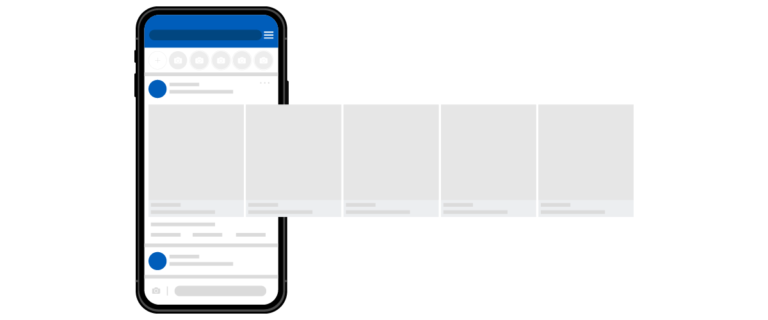
Playable ads
The playable ad is an interactive format that has experienced significant growth in recent years. The ads enable users to try out the core functionality of an app or game, like a free demo, before committing to a download.
Playables have proven effective for increasing conversions and retention, and ultimately, player LTV and revenue.
Native ads
Native ads blend in well with the content of the site or app that presents them in terms of form and function. A more subtle form of advertising, native ads are non-intrusive.
Users often engage without realizing they’ve clicked on an ad. They’ve proven to earn higher views and shares than the other ad content formats.
Social media ads
As we discussed in chapter 4 of this guide, social media advertising provides a cost-effective alternative to TV, radio or newspaper ads.
Social media ads have the versatility to be wherever the consumer is. When a consumer is directly targeted based on their interests or through a social media influencer they trust, they are more likely to convert.
Mobile ad sizes and formats
Let’s take a look at the most common mobile ad sizes offered.

300×250 (Medium rectangle)
- A high performing ad unit and the most popular ad size
- Placement above the fold increases viewability and potential for user engagement.
- The large mobile display ad size tends to generate better revenues
336×280 (Large rectangle)
- Another top performing ad size as suggested by Google
- Performs especially well when used inline, within text content, or at the end of articles
320×480
- The standard for full-screen interstitials
- Proven to yield higher engagement rates
320×50
- The standard for mobile banners
- Best implemented as a docked/anchor unit
How to measure the performance of your ad creative
You can – and should – measure the performance of your ads and optimize campaigns.
While you can do so by scrutinizing a number of parameters such as media type, network, bids, time of week, time of day, and more, collecting performance metrics as it relates to the ad’s messaging and design may prove to be the most impactful. This is your ad creative.
A/B testing is paramount to your success. You conduct A/B tests by concurrently running two versions of each ad, where a single variable such as your icon, headline, description, color palette, layout or visual differs.
Following are other things you can test for your ad creatives:
- Image ad vs. video ad
- Square video ad vs. portrait version
- Video ad vs. a carousel ad with two videos
- Install now call to action vs. a download call to action
Review the various types of mobile app ad formats and experiment with them.
Conduct A/B tests to identify the creative executions that perform best.

Optimizing UA performance with attribution data
User acquisition is an evolution in progress, but its underlying truth remains the same: to generate demand for an app that will lead to positive ROAS and improved profitability.
Doing so requires extracting useful insights about app installs through marketing analytics that are tied to attribution data.
As mentioned earlier in Chapter 2, your attribution and marketing data, especially in its raw, granular form, is truly mission-critical for getting deep insights on your campaigns, enhancing marketing performance, and optimizing your ROAS. It is used to guide budget allocation and inform decision-making on multiple levels: from channel, source, publisher, and campaign to creative.
You can see in the two images below that, within an attribution provider’s dashboard, marketers can monitor KPIs, acquisition trends, and view data broken down by media source, including cost, install data, loyal users, lifetime revenue, ROI, uninstalls, in-app events, assisted installs, and geographical distribution.
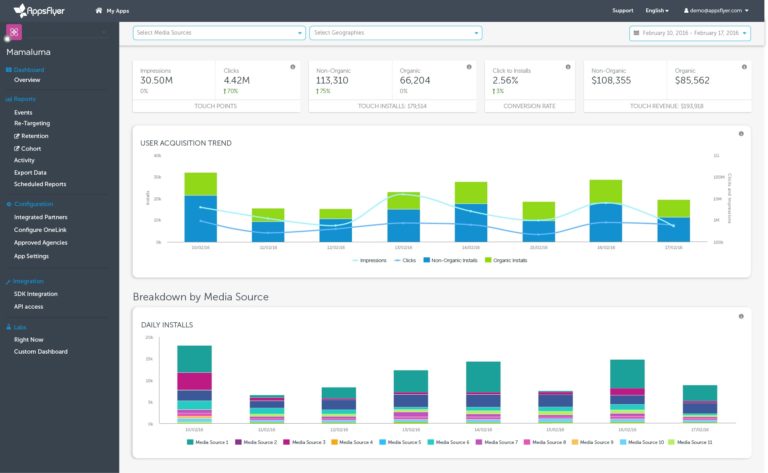
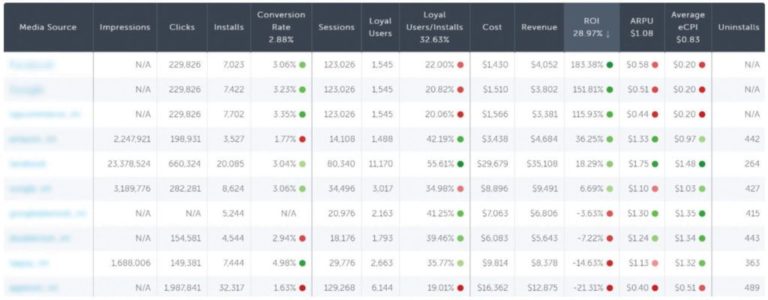
Mobile marketers can get deep insights to learn which promotions drove and/or assisted each install, revealing the customer journey via multi-touch attribution models.
Attribution reports also offer extensive retention and cohort data.
For example, it is clear from the following chart that Network 1 has the highest retention rate from the get go, while Network 2 starts and remains strong, albeit with less favorable performance than Network 1. Network 4 has the lowest retention on Day 1, but over time, it is Network 5 that loses the most users, as only 4.8% remain after 10 days.
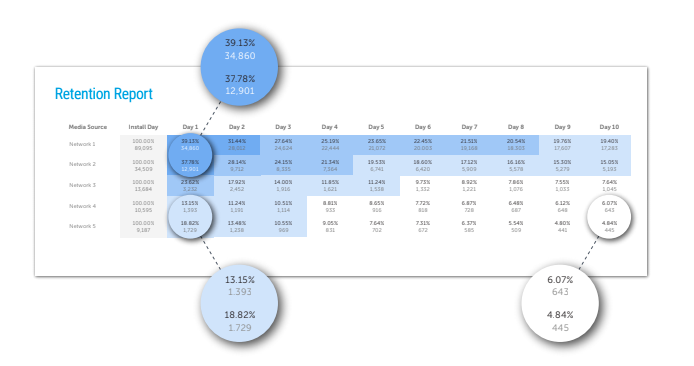
To give more global and regional context to your retention data, check out 2018 App Retention Benchmarks.
On the other hand, a cohort report enables you to segment audiences based on common characteristics and measure specific KPIs over different timeframes.
In the following example, the cohort includes users from Great Britain who installed the app between January 1 and January 31, also grouped by the media source that acquired them.
With this categorization, we can then analyze which network delivered users with the highest average sessions per user over time.
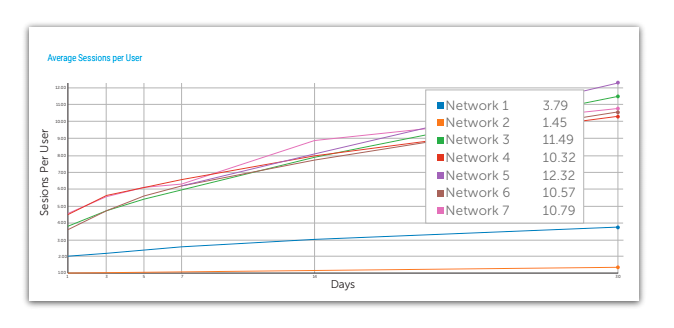
Cohort analysis is distinctly calculated per different timeframes representing the first X activity days per user, and is then accumulated among all users (explaining the graph’s upward direction).
In this case, what are the key insights?
- Networks 1 and 2 underperform and should be considered for removal
- The growth of Network 5 (purple) is most impressive and constant over time – it makes a lot of sense to therefore increase its budget
- As indicated by the dropping curve for Network 7 (pink), engagement is dropping. Perhaps a remarketing campaign before day 14 can help maintain the curve in the long run.
For more information on attribution dashboard reporting, see Getting Started with Mobile Attribution.
Inform future spend decisions with granular measurement of your users’ actions
In today’s complex and competitive mobile landscape, a basic UA strategy that doesn’t factor in specific audience profiles and consumer behaviors simply won’t cut it.
Let’s explore some of the most powerful audience segmentations you can generate to improve your key metrics and bring your app to success.
Boost UA by mapping in-app events that matter
First and foremost, you can increase UA and engagement by mapping important in-app events in your funnel.
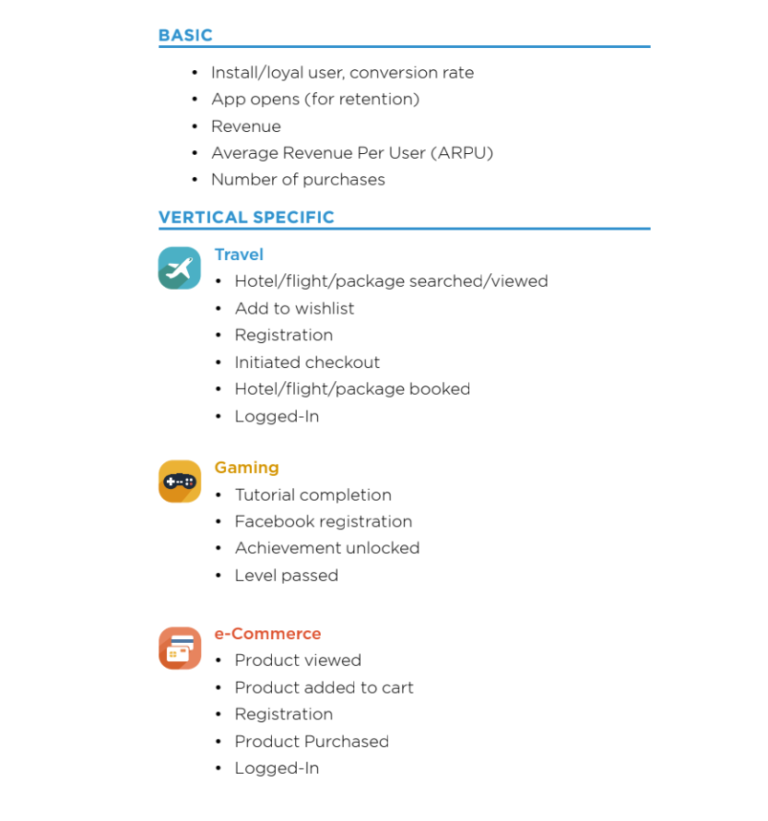
With that data in hand, you can optimize your UA campaigns based on the sources that deliver users with this behavior and deliver customized messaging for more installs, higher engagement, and performance uplift.
In the chart below, we can see a report on ARPU broken down by source.
Assuming that, in this case, we are looking for users with a high threshold of in-app spend, we can see that our email and SMS owned media channels, as well as Networks 1 and 5, are the highest performing and should receive more of our marketing budget.
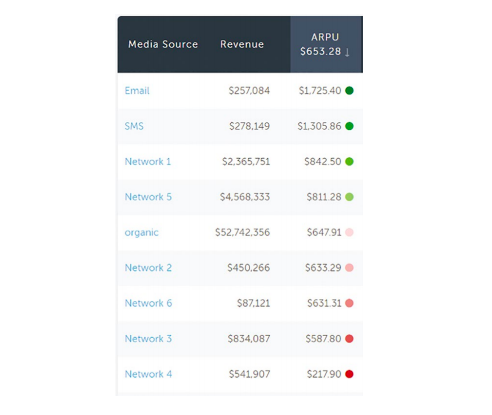
Segment by custom audiences to identify high-value users
Custom audiences are segments of users that have been constructed based on parameters you have already set to define your high-value users.
The idea here is that, once you’ve gathered granular data on these audiences, you can use that to optimize your UA campaigns towards high-value users that similar traits, demographics, interests, and/or behaviors to your converting clients, otherwise known as lookalike audiences.
Note: you can set “lookalike audiences” on Facebook, and perform similar segmentations (called Similar and Tailored Audiences on Google and Twitter, respectively) on other media sources, based on their rich behavioral and demographic data.
Create a segment for cross-app promotions
In some instances of UA, you may have existing active clients who interact frequently with one of your apps, but not with others.
Audiences of those users are therefore low-hanging fruit for increasing installs, engagement, and revenue in other apps, especially more likely if the apps are related in some way. In these situations, in-app push notifications can capture your users during their live engagement.
Remarket to users who didn’t convert
Although this guide is primarily focused on UA, we cannot talk about audience building without mentioning remarketing. The most basic way to optimize with your data is to set up audiences of users who clicked or interacted with your ads but didn’t complete the installation. Remarketing these users can help to improve conversions and re-establish your connection to them for greater retention.
Your marketing analytics will reveal which of your promotions are most fruitful. The data delivered in your attribution dashboard can help you create segmentation strategies for more effective remarketing and tactics to boost engagement and sales.

The essentials of App Store Optimization (ASO) for UA
Search engine optimization in the app ecosystem has its own name: App Store Optimization (ASO).
Most people search for apps in the App Store or Google Play. As such, ASO is a major battleground for app publishers and marketers. However, like Google and other web search engines, the algorithms used by the app stores are mysterious black boxes.
Overall, we can say that in the last couple of years a lot more emphasis has been placed on quality (e.g. app engagement, uninstall rate, reviews, ratings) rather than quantity metrics (sheer number of downloads).
You can liken ASO to SEO for your mobile website, because the overall strategy is the same.
However, some tactics differ.
Also, although the ASO process for both Google Play and Apple’s App Store are based on the same principles, they too differ slightly in execution.
The essentials of ASO fall into three main categories:
- Keywords
- Visuals
- Off-site factors
We’ll dive into each now.
Choosing keywords for ASO
Though search engines continue getting smarter and more semantic, keywords remain the top dog for ASO or any type of search.
The biggest mistake brands make remains the same as well: they put too much emphasis on search volume.
The top priority should be choosing the relevant keywords for which you have the best chance for achieving a high ranking. Keep in mind, a keyword may get thousands of searches a month, but if your app ranking is buried deep in the results, you’ve done yourself no service by attempting to rank for the keyword (or phrase).
Keep in mind:
- Google Play reports that 60 to 75% of the keywords that drive installs target long-tail keywords (three or more words)
- Work with the keyword suggestions provided by the stores – they know what they’re doing
- It’s best to target at least 120 keywords per country
Your ASO strategy depends on getting inside the mind or your customers and unearthing the natural language they use to describe the app they seek.
Here’s a great list of questions to examine, from a guest post on the Moz blog.
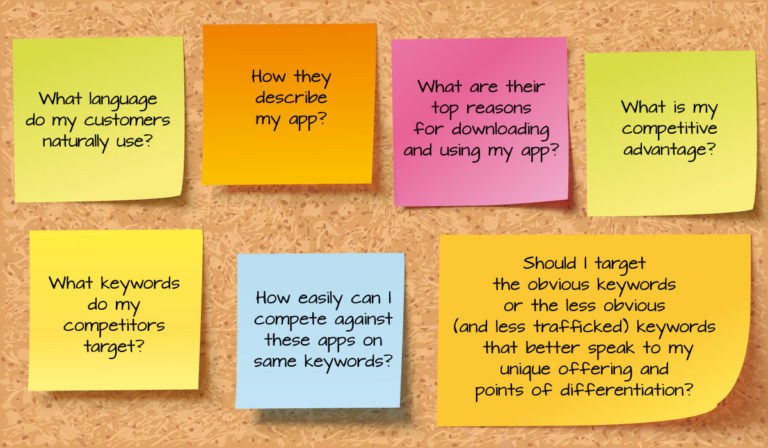
Once you’ve got a list of the keywords you want to target in hand, here’s how to go about using them.
The all-important title keywords
- Don’t use special characters in your app title
- Don’t use category words (free, game, puzzle, etc.)
- Google Play allows for 30 characters
- The App Store will only display the first 25 characters in your title
- The App Store also allows for a total of 100 characters to list your keywords – use them wisely
- Skip stop words
- Separate your keywords with a comma
- Use numerals – don’t write out numbers
- Don’t repeat the app name
The app description
- In this space, offer compelling copy about the features and benefits users can expect from your app
- Don’t keyword stuff but repeat your keywords up to five times
- Front-load the descriptions with keywords so they appear in the truncated descriptions presented
- Don’t use testimonials, but consider mentioning social proof such as awards and reviews
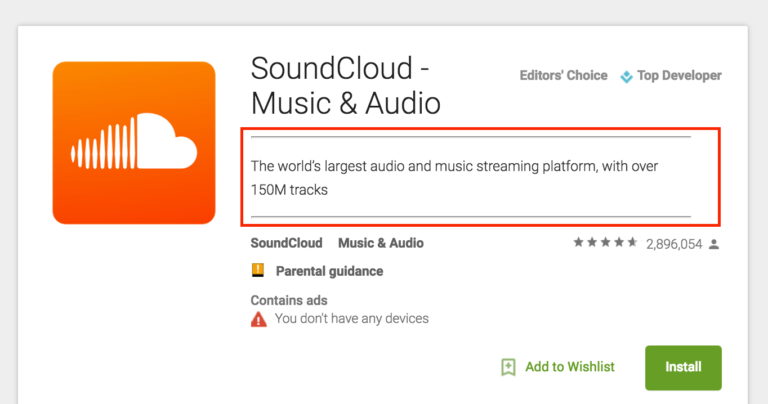
Localization
Treat localization as a key optimization process. If your audience goes beyond the English-speaking world, adapt your communications to the wants and needs of each geo-based audience segment.
- Your product page should be localized for multiple countries
- Depending on your app and target audience, it may be helpful to localize your keywords. Essentially, this means translating your title, the first sentence or two of your description, and your screenshots.
- Localize the graphic elements.
Visuals
Great images can be the difference-maker that inspires users to click on your app.
Technically, your visuals aren’t going to affect your rankings, but they will affect click-through results.
- Your app’s icon makes an important first impression. Make sure it’s simple, but consistent with the app’s design and company brand. Don’t use text.
- Both app stores provide slots for multiple screenshots. Use them all, but pay special attention to the top two slots. Avoid dull screens such as menus.
- Screenshots should show off your app’s best features, latest updates, and the pages on which your customers will spend the most time.
Video
You can also add a preview or promotional video to your app page, which can be extremely compelling. Make your video exciting in the first few seconds.
Off-site ASO factors
You can’t control off-site ASO factors, but each of the following have an impact on your rankings:
- User feedback
- Apps that have the most positive ratings will consistently surface at the top of the charts. Ratings are all-important for both rankings and conversion.
- Ratings extend beyond app store optimization into the realm of online marketing. For example, Facebook’s App Install Ads and Twitter’s App Cards pull an app’s average rating and display it alongside only the app’s name and icon
- Ensure at least 1% of your users rate it.
- Maintain an average rating of at least 4-stars, and of course, aim to earn 5-star reviews.
- Volume of downloads and uninstalls
- User engagement (opens, session length, etc.)
- Retention and re-engagementUpdating your app encourages users to re-discover portions of your app and improve retention.
- Leverage push notifications to encourage re-engagement (and sales).
- Bonus tip: Push notifications containing emojis are opened at higher rate.
- Growth trend line
Outside promotion
ASO experts believe your app’s total page visits and product page backlinks are also factors determining your search ranking.
The basic idea: the more traffic your listing gets, the higher it will rank in search results.
You can drive traffic to your listing by:
- Posting social media updates
- Publishing content
- Soliciting press and reviews
- Running ads
App indexing
Gone are the days when apps were an isolated silo separate from the web. Today, it’s common for people to use multiple devices and platforms to perform the same task, and it’s even possible to discover mobile app-only content via desktop search.
Enter app indexing – the process of making app content searchable and linkable from a web or mobile web search.
In 2015, Google began indexing Android and iOS apps. App content can now be discovered and deep-linked from a Google search. Bing has done the same.

When users who does not have your app installed click on a search result, the deep link redirects them to the app store listing page. If they do have it installed, they arrive on the page in your app from which the content is indexed. As such, app indexing helps with both re-engagement and acquisition by promoting your content in new channels.
A case study by Google (from 2016) states 50 billion links within apps are indexed and 25% of searches on Android return deep links to apps for signed-in users.
Ongoing optimization
Though you’ve taken care of the ASO basics, remember it’s a process.
Conduct regular testing, analysis, and optimization of the various elements of your app page and listing. Look at what your successful competitors are doing and see if there you can apply even more optimizations.
Mastering ASO calls for a keen understanding of keywords and using them alongside the most impactful visuals. While you can’t control off-site ASO factors, keep in mind that they too will affect your rankings.




